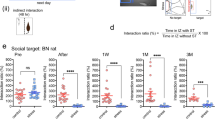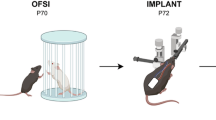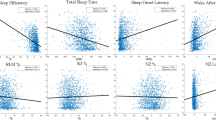Abstract
Aim:
Disrupted sleep may be a prodromal symptom or a predictor of depressive disorders. In this study we investigated the relationship between depression symptoms and disrupted sleep using a novel model of stress-mimicked sleep disorders in rats.
Methods:
SD rats were injected with corticosterone (10, 20 or 40 mg/kg, sc) or vehicle for 7 d. Their sleep-wake behavior was monitored through implanted EEG and EMG electrodes. Their depressive behaviors were assessed using forced swim test, open field test and sucrose preference test.
Results:
The corticosterone-treated rats showed significantly reduced sleep time, disinhibition of rapid-eye-movement (REM) sleep and altered power spectra during non-REM sleep. All depressive behavioral tests did not show significant difference across the groups. However, individual correlation analysis revealed statistically significance: the immobility time (despair) was negatively correlated with REM sleep latency, slow wave sleep (SWS) time ratio, SWS bouts and delta power density, and it was positively correlated with REM sleep bouts and beta power density. Meanwhile, sucrose preference (anhedonia) was positively correlated with total sleep time and light sleep bouts, and it was negatively correlated with the REM sleep time ratio.
Conclusion:
In stress-mimicked rats, sleep disturbances are a predictor of depressive disorders, and certain symptoms of depression may be related to the disruption of several specific sleep parameters.
Similar content being viewed by others
Log in or create a free account to read this content
Gain free access to this article, as well as selected content from this journal and more on nature.com
or
References
Pigeon WR . Insomnia as a predictor of depression: do insomnia subtypes matter? Sleep 2010; 33: 1585–6.
Salo P, Sivertsen B, Oksanen T, Sjosten N, Pentti J, Virtanen M, et al. Insomnia symptoms as a predictor of incident treatment for depression: prospective cohort study of 40,791 men and women. Sleep Med 2012; 13: 278–84.
Breslau N, Roth T, Rosenthal L, Andreski P . Sleep disturbance and psychiatric disorders: a longitudinal epidemiological study of young adults. Biol Psychiatry 1996; 39: 411–8.
Chang PP, Ford DE, Mead LA, Cooper-Patrick L, Klag MJ . Insomnia in young men and subsequent depression. The Johns Hopkins Precursors Study. Am J Epidemiol 1997; 146: 105–14.
Foley DJ, Monjan A, Simonsick EM, Wallace RB, Blazer DG . Incidence and remission of insomnia among elderly adults: an epidemiologic study of 6,800 persons over three years. Sleep 1999; 22 Suppl 2: S366–72.
Ford DE, Kamerow DB . Epidemiologic study of sleep disturbances and psychiatric disorders. An opportunity for prevention? JAMA 1989; 262: 1479–84.
Weissman MM, Greenwald S, Nino-Murcia G, Dement WC . The morbidity of insomnia uncomplicated by psychiatric disorders. Gen Hosp Psychiatry 1997; 19: 245–50.
Park EM, Meltzer-Brody S, Stickgold R . Poor sleep maintenance and subjective sleep quality are associated with postpartum maternal depression symptom severity. Arch Womens Ment Health 2013; 16: 539–47.
Kupfer DJ, Frank E, McEachran AB, Grochocinski VJ . Delta sleep ratio. A biological correlate of early recurrence in unipolar affective disorder. Arch Gen Psychiatry 1990; 47: 1100–5.
Giles DE, Roffwarg HP, Schlesser MA, Rush AJ . Which endogenous depressive symptoms relate to REM latency reduction? Biol Psychiatry 1986; 21: 473–82.
Staner L . Comorbidity of insomnia and depression. Sleep Med Rev 2009; 14: 35–46.
Rao U, Hammen CL, Poland RE . Risk markers for depression in adolescents: sleep and HPA measures. Neuropsychopharmacology 2009; 34: 1936–45.
de Kloet ER, Joëls M, Holsboer F . stress and the brain: from adaptation to disease. Nat Rev Neurosci 2005; 6: 463–75.
Burke HM, Davis MC, Otte C, Mohr DC . Depression and cortisol responses to psychological stress: a meta-analysis. Psychoneuroendocrinology 2005; 30: 846–56.
Sterner EY, Kalynchuk LE . Behavioral and neurobiological consequences of prolonged glucocorticoid exposure in rats: relevance to depression. Prog Neuropsychopharmacol Biol Psychiatry 2010; 34: 777–90.
Johnson SA, Fournier NM, Kalynchuk LE . Effect of different doses of corticosterone on depression-like behavior and HPA axis responses to a novel stressor. Behav Brain Res 2006; 168: 280–8.
Marks W, Fournier NM, Kalynchuk LE . Repeated exposure to corticosterone increases depression-like behavior in two different versions of the forced swim test without altering nonspecific locomotor activity or muscle strength. Physiol Behav 2009; 98: 67–72.
Nestler EJ, Gould E, Manji H, Buncan M, Duman RS, Greshenfeld HK, et al. Preclinical models: status of basic research in depression. Biol Psychiatry 2002; 52: 503–28.
Cui SY, Cui XY, Zhang J, Wang ZJ, Yu B, Sheng ZF, et al. Ca(2)+ modulation in dorsal raphe plays an important role in NREM and REM sleep regulation during pentobarbital hypnosis. Brain Res 2011; 1403: 12–8.
Papp M, Willner P, Muscat R . An animal model of anhedonia: attenuation of sucrose consumption and place preference conditioning by chronic unpredictable mild stress. Psychopharmacology (Berl) 1991; 104: 255–9.
Lustberg L, Reynolds CF . Depression and insomnia: questions of cause and effect. Sleep Med Rev 2000; 4: 253–62.
Thase ME . Antidepressant treatment of the depressed patient with insomnia. J Clin Psychiatry 1999; 60 Suppl 17: 28–31; discussion 46–8.
Turek FW . Insomnia and depression: if it looks and walks like a duck. Sleep 2005; 28: 1362–3.
Pigeon W, Perlis M . Insomnia and depression: birds of a feather? Int J Sleep Disord 2007; 1: 82–91.
Kupfer DJ, Foster FG . Interval between onset of sleep and rapid-eye-movement sleep as an indicator of depression. Lancet 1972; 2: 684–6.
Spiker DG, Coble P, Cofsky J, Foster FG, Kupfer DJ . EEG sleep and severity of depression. Biol Psychiatry 1978; 13: 485–8.
Manber R, Edinger JD, Gress JL, San Pedro-Salcedo MG, Kuo TF, Kalista T . Cognitive behavioral therapy for insomnia enhances depression outcome in patients with comorbid major depressive disorder and insomnia. Sleep 2008; 31: 489–95.
Fava M, McCall WV, Krystal A, Wessel T, Rubens R, Caron J, et al. Eszopiclone co-administered with fluoxetine in patients with insomnia coexisting with major depressive disorder. Biol Psychiatry 2006; 59: 1052–60.
Nestler EJ, Barrot M, DiLeone RJ, Eisch AJ, Gold SJ, Monteggia LM . Neurobiology of depression. Neuron 2002; 34: 13–25.
Steiger A, Dresler M, Kluge M, Schussler P . Pathology of sleep, hormones and depression. Pharmacopsychiatry 2013; 46 Suppl 1: S30–5.
Lussier AL, Lebedeva K, Fenton EY, Guskjolen A, Caruncho HJ, Kalynchuk LE . The progressive development of depression-like behavior in corticosterone-treated rats is paralleled by slowed granule cell maturation and decreased reelin expression in the adult dentate gyrus. Neuropharmacology 2013; 71: 174–83.
Steiger A, Kimura M . Wake and sleep EEG provide biomarkers in depression. J Psychiatr Res 2010; 44: 242–52.
McCarley RW, Hobson JA . Neuronal excitability modulation over the sleep cycle: a structural and mathematical model. Science 1975; 189: 58–60.
Kupfer DJ, Spiker DG, Rossi A, Coble PA, Shaw D, Ulrich R . Nortriptyline and EEG sleep in depressed patients. Biol Psychiatry 1982; 17: 535–46.
Sharpley AL, Cowen PJ . Effect of pharmacologic treatments on the sleep of depressed patients. Biol Psychiatry 1995; 37: 85–98.
Saper CB, Fuller PM, Pedersen NP, Lu J, Scammell TE . Sleep state switching. Neuron 2010; 68: 1023–42.
Holmstrand EC, Sesack SR . Projections from the rat pedunculopontine and laterodorsal tegmental nuclei to the anterior thalamus and ventral tegmental area arise from largely separate populations of neurons. Brain Struct Funct 2011; 216: 331–45.
Tsujino N, Sakurai T . Orexin/hypocretin: a neuropeptide at the interface of sleep, energy homeostasis, and reward system. Pharmacol Rev 2009; 61: 162–76.
Maquet P, Degueldre C, Delfiore G, Aerts J, Peters JM, Luxen A, et al. Functional neuroanatomy of human slow wave sleep. J Neurosci 1997; 17: 2807–12.
Drevets WC . Orbitofrontal cortex function and structure in depression. Ann N Y Acad Sci 2007; 1121: 499–527.
Merica H, Fortune RD . A neuronal transition probability model for the evolution of power in the sigma and delta frequency bands of sleep EEG. Physiol Behav 1997; 62: 585–9.
Chen CR, Zhou XZ, Luo YJ, Huang ZL, Urade Y, Qu WM . Magnolol, a major bioactive constituent of the bark of Magnolia officinalis, induces sleep via the benzodiazepine site of GABA(A) receptor in mice. Neuropharmacology 2012; 63: 1191–9.
Nofzinger EA, Price JC, Meltzer CC, Buysse DJ, Villemagne VL, Miewald JM, et al. Towards a neurobiology of dysfunctional arousal in depression: the relationship between beta EEG power and regional cerebral glucose metabolism during NREM sleep. Psychiatry Res 2000; 98: 71–91.
Armitage R, Emslie GJ, Hoffmann RF, Rintelmann J, Rush AJ . Delta sleep EEG in depressed adolescent females and healthy controls. J Affect Disord 2001; 63: 139–48.
Kupfer DJ, Ehlers CL, Frank E, Grochocinski VJ, McEachran AB, Buhari A . Persistent effects of antidepressants: EEG sleep studies in depressed patients during maintenance treatment. Biol Psychiatry 1994; 35: 781–93.
Acknowledgements
This study was funded by grants from the National Natural Science Foundation of China (No 81173031, 81202511 and 81302746).
Author information
Authors and Affiliations
Corresponding author
Rights and permissions
About this article
Cite this article
Wang, Zj., Yu, B., Zhang, Xq. et al. Correlations between depression behaviors and sleep parameters after repeated corticosterone injections in rats. Acta Pharmacol Sin 35, 879–888 (2014). https://doi.org/10.1038/aps.2014.44
Received:
Accepted:
Published:
Issue date:
DOI: https://doi.org/10.1038/aps.2014.44



